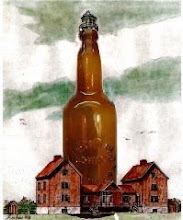A secondary fermenter really isn't necessary, unless doing something like adding fruit or dry hopping. Leave it in the primary 3-4 weeks and you're good to go. Autolysis? Nope, not here. The beer is better than ever.
This was confirmed on a March episode of Brew Strong where John Palmer and Jamil Zainasheff talk about how secondary fermentation is an outdated homebrewing technique. John even says that the information in the 1st edition of How to Brew (the web version) is no longer relevant.
John: As we've gotten more educated on how much good healthy yeast you need for optimum fermentation the advice that we used to give 20 years ago has changed. 10 years ago, 20 years ago, homebrewers were using with a single packet of dry yeast that was taped to the top of the can. There weren't as many liquid yeast cultures available.
Jamil: People didn't make starters either.
John: Right. So the whole health and vitality of yeast was different back then compared to know. Back then it made sense. You had weaker yeast that had finished fermentation that were more susceptible to autolysis and breaking down. Now that is not the case. The bar of homebrewing has risen to where we are able to make beer that has the same robustness as professional beer. We've gotten our techniques and understanding of what makes a good fermentation up to that level, so you don't need to transfer the beer off the yeast to avoid autolysis like we used to recommend.
Jamil: Unless you are going to do long term at warm temperatures, but even then we are talking over a month. I thought about this as well and I think one of the reasons autolysis....and the fact that people were using weak yeast in inappropriate amounts and the transfer would add some oxygen to it which would help attenuate a few more points. I think that was part of the deal why transferring was considered appropriate years ago.
John: But these days we don't recommend secondary transfer. Leave it in the primary, you know, a month. Today's fermentations are typically healthy enough that you are not going to get autolysis flavors or off-flavors from leaving the beer on the yeast for an extended period of time.
Jamil: And if you are using healthy yeast and the appropriate amount and the thing is... homebrew style fermentors..if you are using a carboy or plastic bucket which have that broad base when the yeast flocculate out they lay in a nice thin layer. When you're dealing with large, tall...one of the things you know people go "Well the commercial brewers they remove the yeast because it is gonna break down, die, and make the beer bad. We should be doing the same thing." That's where alot of this comes from. But the commerical brewers are working with 100 bbl fermenters that are very tall and put a lot of pressure on the yeast. The yeast are jammed into this little cone in the bottom and they are stacked very deep and there is a lot of heat buildup. The core of that yeast mass can be several degrees C higher than the rest of that yeast mass and it can actually cook the yeast and cause them to die faster and cause those problems with flavor and within a couple of days the viability of that yeast which the commercial brewers are going to reuse is going to drop 25%, 50% over a couple of days so they need to get that yeast out of there. You don't have that restriction as a homebrewer. You've got these broad fermenter bases that allow the yeast to be distributed evently. It's an advantage for cleaning up the beer. You have the advantage that the yeast don't break down as fast. You don't have as high a head pressure. There are a lot of advantages.
Thursday, September 30, 2010
Subscribe to:
Comments (Atom)


